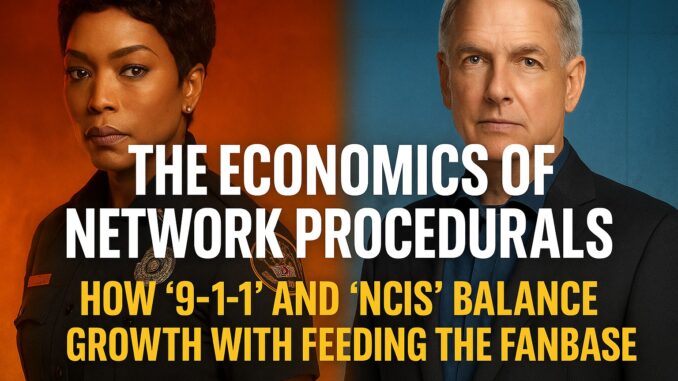
The third entry in the “9-1-1” franchise, “9-1-1: Nashville,” is set to premiere in October and the seventh installment in the NCIS franchise, “NCIS: Tony & Ziva,” just premiered this month. Is the rapid proliferation of procedural spinoffs an indicator that their creators have cracked the code on a winning formula or is there a risk that these franchises will reach a saturation point and begin to see diminishing returns?
There is no doubt that the procedural format has successfully made the transition from its linear origins to the streaming era. Shows like “NCIS” and “Criminal Minds” have paid dividends for the platforms they are on. Parrot Analytics’ Streaming Economics model calculates that since 2020, the original “NCIS” series itself has brought in nearly $200M in streaming revenue globally for Netflix alone.
Procedurals are known for long tail value because of huge episode libraries. With more than two decades of back catalog, the financial calculation of “NCIS” is different from a “9-1-1.” A newer franchise with fewer spinoffs like “9-1-1” may be more in growth mode, and looking to bring new audiences to the franchise. For “NCIS,” the most impactful move may be to draw in proven fans of the franchise to a platform where they will find essentially a bottomless supply of old “NCIS” episodes to stream, an effective asset for retaining them once they are signed on.
We can see how “9-1-1: Lone Star” made inroads with new audiences that were not engaged with the original series. Of the total audience of the original “9-1-1,” 8% was under age 32. But “Lone Star” was more successful in breaking through with younger audiences, with nearly 55% of the spinoff’s audience younger than 32. “Lone Star” also did a better job bringing in male audiences compared to the original series, where 74% of the audience was female.
Contrast this with the NCIS franchise which has had, consistently across six series, over 70% of its audience over the age of 30. Has doubling down on its core audience hit a ceiling for “NCIS?” Last year’s premiere of “NCIS: Origins” saw some of the highest demand for a new series premiere in the franchise, averaging over 20 times the average series demand globally over the course of its first season. So far, “Tony & Ziva” is significantly lagging that with less than 5x demand globally to date.
Network television may not dominate the cultural conversation like it once did, but procedural dramas like ‘9-1-1’ and ‘NCIS’ prove that the genre is far from dead. These shows aren’t just surviving; they’re thriving—balancing profitability with keeping loyal audiences satisfied. Let’s dive deep into the economics, creative strategies, and audience dynamics that keep these fan-favorite series running strong.
Why Procedural Dramas Still Rule the Ratings
Procedural shows have a magic formula: familiar structure, fresh cases, and characters that feel like family. This combination makes them both addictive for viewers and lucrative for networks. Unlike prestige dramas that often chase awards, procedurals are built for longevity and stability.
The Business Model Behind Procedurals
At their core, procedurals are designed to be cost-effective cash cows. Here’s why they’re so attractive to networks:
-
Repeatability: Each episode has a self-contained story, meaning reruns never feel outdated.
-
Syndication Gold: After crossing 100 episodes, shows like NCIS become licensing machines.
-
International Appeal: Crime, rescue, and heroism are universal languages.
Case Study: NCIS and Its Expanding Universe
‘NCIS’ is more than a show—it’s a franchise. Spinoffs like NCIS: Los Angeles, NCIS: New Orleans, and NCIS: Hawai’i prove how one hit can spawn multiple profitable streams.
How NCIS Monetizes Its Popularity
-
Syndication Deals – Airing endlessly on cable and streaming platforms.
-
Global Distribution – Huge international fanbases in Europe and Asia.
-
Merchandising & Branding – Books, fan conventions, and memorabilia.
‘9-1-1’: The Modern Procedural Powerhouse
While NCIS thrives on military intrigue and investigative suspense, ‘9-1-1’ takes a more modern, high-stakes approach. Its stories aren’t limited to police or firehouses—it’s about chaos, humanity, and survival.
Why ‘9-1-1’ Wins Today’s Viewers
-
Disaster Spectacle: Big-budget stunts pull in casual viewers.
-
Character Depth: Emotional arcs keep fans invested long-term.
-
Relatable Themes: Every crisis feels connected to everyday life.
The Economics of Fan Loyalty
A loyal fanbase is the secret sauce. Both shows invest in character-driven storytelling, ensuring fans don’t just watch for the cases, but for the people solving them.
-
Fans binge-watch past seasons.
-
Online communities amplify engagement.
-
Networks capitalize on social buzz.
Balancing Growth With Fan Expectations
Too much change can alienate fans, but too little evolution leads to stagnation. The trick is innovation without disruption.
-
NCIS carefully introduces new cast members to replace departing stars.
-
9-1-1 shifts its storylines to reflect modern anxieties while keeping core relationships steady.
Streaming vs. Network: The New Battlefield
Procedurals face a two-front war: keeping traditional network audiences happy while appealing to streaming-first generations.
-
Networks rely on live viewers for ad revenue.
-
Streaming gives shows longevity beyond weekly broadcasts.
-
Both NCIS and 9-1-1 thrive on platforms like Hulu, Paramount+, and Netflix.
Why Procedurals Outlast Trendy Dramas
Prestige shows may grab headlines, but procedurals win the marathon of TV longevity.
-
Viewers crave reliability after work.
-
Procedurals are the TV equivalent of comfort food.
-
They’re less risky than experimental storytelling.
Behind-the-Scenes Economics
Budgets and Profits
-
Procedurals usually have mid-range budgets, compared to high-cost fantasy shows.
-
Special effects are used strategically (big stunts in 9-1-1, but not every week).
-
Strong ensemble casts reduce dependence on single megastars.
The Role of Advertisers
Advertisers love procedurals because:
-
Their audiences skew older and loyal.
-
They guarantee consistent viewership numbers.
-
Product placement feels natural in everyday settings.
The Human Factor: Stars and Salaries
Shows like NCIS have weathered big cast departures (Michael Weatherly, Pauley Perrette) by making sure the story trumps any one actor. Meanwhile, 9-1-1 relies heavily on its ensemble chemistry—losing a key star could shift the balance.
Cultural Impact of Procedural Dramas
Procedurals don’t just entertain; they reflect cultural anxieties.
-
NCIS taps into national security fears.
-
9-1-1 explores personal and societal crises in modern America.

The Future of Procedural Economics
With rising streaming costs, procedurals are a safe investment for networks. Expect:
-
More spinoffs (NCIS: Sydney is already here).
-
Globalized production to cut costs.
-
Hybrid network-streaming models for maximum revenue.
Why Fans Keep Coming Back
At the end of the day, audiences don’t just tune in for explosions or mysteries. They return for connection—the comfort of seeing familiar faces tackle extraordinary challenges week after week.
Conclusion
Procedural dramas like NCIS and 9-1-1 prove that the economics of television is about more than flashy prestige projects. These shows balance profitability with loyalty, ensuring fans are satisfied while networks make billions. In the evolving world of media, procedurals remain the heartbeat of network TV, blending financial strategy with emotional storytelling.
FAQs
1. Why are procedurals like ‘NCIS’ and ‘9-1-1’ so successful?
Because they blend consistent storytelling with relatable characters, making them both rewatchable and emotionally engaging.
2. How do these shows make money beyond TV ads?
Through syndication, international sales, streaming deals, and merchandising.
3. Which show is more profitable—‘NCIS’ or ‘9-1-1’?
NCIS holds the crown due to its decades-long run and multiple spinoffs, but 9-1-1 is a modern ratings powerhouse.
4. Will procedurals survive the streaming era?
Yes. Their flexible format and global appeal make them adaptable across platforms.
5. Why do fans remain so loyal to procedural dramas?
Because the characters feel like family, and the shows deliver reliable entertainment in uncertain times.
